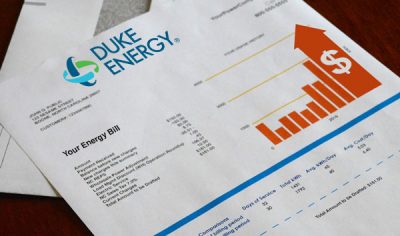Front Porch Blog

Critics of Duke’s original carbon plan rally outside Charlotte public hearing on the plan last year. Photo by Tracy Watts
By Maddy Koch and Naomi Albert
Duke Energy has a lot going on. Even if you’re following their every move, it might be hard to keep it all straight. Duke Energy is the largest electricity provider in North Carolina, and we believe Duke is not doing enough to help with increasing renewable energy in the state or keeping energy bills low for all customers. However, there were some substantial wins that support low-income customers with bill assistance and will increase accessibility to energy efficiency upgrades. These wins demonstrate just how important it is for the public to put pressure on this monopoly utility company!
Duke Energy rate cases
Duke Energy has two companies operating in North Carolina — Duke Energy Progress and Duke Energy Carolinas. Both filed to raise their rates in the last year. The Duke Energy Progress rate change was finalized in August just marginally reducing Duke’s exorbitant request. Duke Energy Carolina’s rate case decision is expected this December.
The decision for Duke Energy Progress came after the North Carolina Utilities Commission, which oversees both Duke Energy companies, traveled across the state hearing testimony from residents already struggling to pay their bills. Despite consistent feedback from the public at each hearing that Duke’s request was far too high, the utilities commission only marginally reduced the rate from Duke’s proposed increased return on equity from 10.3% to 9.8%. The impact this will have on bills is an average increase of $23.77 per month over the next three years for a home using about 1,000 kilowatt-hours a month. The Duke Energy Carolinas decision is expected by the end of the year.

Map from Action Pathways
Duke’s new “tariff-on-bill” financing program — something to celebrate!
Energy transition requires that utility companies don’t just look at how power is generated but how much is actually needed. Reducing the amount of energy that is needed is a huge part of reducing emissions. It’s a part of the puzzle that companies like Duke Energy try to avoid because their business model relies on building new supply, not reducing demand.

Graphic created by Appalachian Voices staff
These types of programs can have big impacts. In May, Appalachian Voices shared an analysis from PSE Energy on Winter Storm Elliot’s rolling blackouts in December 2022 and how they could have been avoided. In their analysis, PSE focused primarily on programs that reduce demand on the grid, especially in extreme weather. Following PSE’s assumptions about Duke customers using electric resistance heating, Duke could see a reduction of peak demand as high as 200 megawatts if 629,000 homes switched to more efficient electric heat pumps.
The primary hurdle to this kind of shift is the upfront cash. This program eliminates substantial barriers for so many across the state, now switching to a heat pump as a qualifying Duke customer has never been more financially feasible.
Appalachian Voices and others, including the North Carolina Justice Center, advocated for a program like this in our comments on Duke Energy’s Carbon plan.
Unfortunately, this next phase of the carbon plan, which must be updated every two years, does little to further demand reduction and will continue to harm directly impacted communities with gas expansion while pushing off Duke’s original deadline to cut climate-changing emissions.
Carbon Plan 2.0
In August, Duke released a draft update to the North Carolina Carbon Plan. We’ll refer to this update as Carbon Plan 2.0. Unfortunately, the draft Carbon Plan 2.0 would represent a big step backward for clean energy and North Carolina ratepayers. The Carbon Plan is the result of a 2021 law, HB 951, that requires the North Carolina Utilities Commission to develop a plan to reduce carbon emissions by 70% from 2005 levels by 2030 and reach carbon neutrality by 2050. This law only applies to Duke Energy and requires updates every two years.

Rallygoers attend the final carbon plan meeting last year to urge the North Carolina Utilities Commission to reject Duke Energy’s Carbon Plan. Photo by Jennifer Roberts
Carbon Plan 2.0 is more of the same: unmet deadlines, untested technologies and unnecessary methane gas development. By 2033, Duke’s new proposal would build 74% more new methane gas generation compared to the original plan by 2035. It also delays the near-term retirement of several coal plants even as electricity produced by coal becomes increasingly expensive for customers. Both gas and coal pose substantial risks for North Carolinians’ access to affordable, clean and reliable power.
On Dec. 24, 2022, the leading cause of power outages during Winter Storm Elliot was fossil fuel facilities, specifically gas and coal. Yet Duke continues to ask the utilities commission to allow them to invest in these types of energy sources. Duke doesn’t plan to use these fuels forever, which means ratepayers carry the burden of the cost even after the plants close.
Instead, Duke could more heavily invest in wind and solar, which will continue to provide power over the full lifetime of the facility. These technologies are also already proven and reliable, unlike Duke’s proposed hydrogen gas and small modular nuclear facilities. In Duke’s own words, all proposed energy mixes in the plan rely on “breakthroughs” in advanced nuclear small modular reactors and hydrogen-capable gas. We can’t wait around for technological breakthroughs when people need reliable power.
Although Duke’s proposal is extremely disappointing, there is still time to advocate for a better plan. The Carbon Plan is the responsibility of the North Carolina Utilities Commission, and we need them to stop conceding to Duke Energy. Advocates in North Carolina will be able to submit comments on the plan and become intervenors in the proceeding. Appalachian Voices intervened in the last round, and while the results were disappointing, we still believe that our voices at the NCUC will make a difference.
Ultimately, we hope to see a final plan that will allow for a cleaner, more affordable and reliable electrical grid for North Carolina. Stay tuned for a deeper dive into the Carbon Plan 2.0 and how to get involved!
Maddy Koch and Naomi Albert are our North Carolina field coordinators for our Energy Democracy program.
PREVIOUS
NEXT
Related News

Leave a comment
Your email address will not be published. Required fields are marked *
